A town located in the Galle District of the Southern Province in Sri Lanka ‘ Ambalangoda ‘ – By Malsha – eLanka
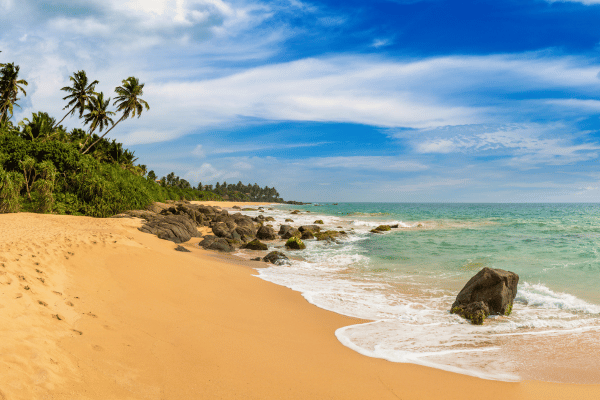
Ambalangoda Beach
Ambalangoda is a town located in the Galle District of the Southern Province in Sri Lanka. It is situated along the southwestern coast of the country, approximately 90 kilometers south of the capital city, Colombo. Ambalangoda is known for its rich cultural heritage, traditional mask-making, and vibrant performing arts.
The town is famous for its traditional Sri Lankan wooden masks, which are intricately carved and painted by skilled artisans. These masks play a significant role in traditional rituals, ceremonies, and folk dances. Visitors to Ambalangoda can explore workshops and galleries where they can witness the creation process and even purchase masks as souvenirs.
In addition to mask-making, Ambalangoda is also known for its traditional puppetry, known as “Raksha Keliya” or “Yak Keliya.” Puppet shows are performed using intricate and colorful puppets, and they often depict traditional folklore and stories from Sri Lankan culture.
Ambalangoda is blessed with beautiful beaches and is a popular destination for both local and international tourists. The town’s coastal area offers opportunities for swimming, sunbathing, and enjoying the scenic beauty of the Indian Ocean. The nearby Madu River is another attraction, where visitors can take boat rides through the mangrove forests and explore small islands.
The town has a lively market where you can find local produce, spices, handicrafts, and other goods. It’s also worth visiting the historical sites in Ambalangoda, such as the ancient Buddhist temple called “Maha Samudraramaya,” which dates back to the 19th century.
Overall, Ambalangoda is a culturally rich town that offers a unique glimpse into Sri Lanka’s traditional arts and crafts. It is a destination that combines natural beauty, cultural heritage, and warm hospitality, making it a must-visit place for travelers seeking an authentic Sri Lankan experience.
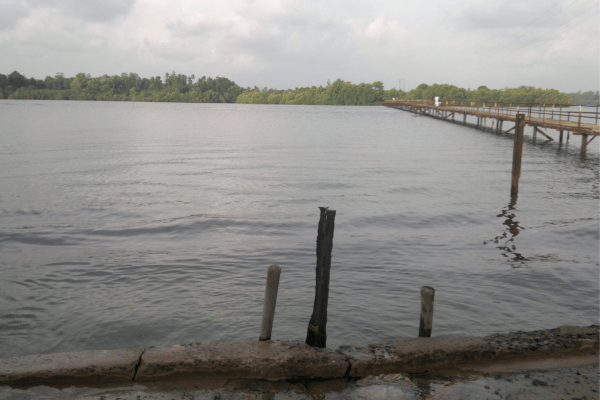
Ambalangoda is famous for several reasons that have contributed to its recognition and reputation. Here are some key factors that make Ambalangoda famous:
- Traditional Mask-Making: Ambalangoda is renowned for its traditional mask-making industry. The town is home to skilled artisans who have mastered the art of carving and painting masks. The masks produced in Ambalangoda are highly regarded for their intricate craftsmanship, vibrant colors, and cultural significance.
- Cultural Heritage: Ambalangoda has a rich cultural heritage deeply rooted in Sri Lankan traditions. The town preserves and celebrates its cultural practices, including traditional rituals, folk dances, and performances that prominently feature masks. This cultural heritage has attracted attention and interest from locals and tourists alike.
- Mask Museum and Workshops: Ambalangoda hosts a Mask Museum and several workshops dedicated to preserving and promoting the art of mask-making. These establishments provide visitors with insights into the history, techniques, and cultural significance of Ambalangoda masks. They have become popular attractions, attracting tourists and art enthusiasts.
- Performing Arts: Ambalangoda is known for its vibrant performing arts scene, particularly the traditional devil dances known as “Raksha Keliya” or “Yak Keliya.” These performances incorporate masks and showcase the region’s unique cultural heritage. Ambalangoda has gained recognition for its contributions to Sri Lankan performing arts.
- Artistic Expression: The masks of Ambalangoda serve as a form of artistic expression, reflecting the creativity, skill, and cultural identity of the artisans. Their intricate designs, vibrant colors, and detailed carvings have garnered appreciation and admiration from both locals and visitors.
- Tourism: Ambalangoda’s cultural heritage and artistic traditions have made it a popular tourist destination. Travelers from around the world visit the town to experience its unique atmosphere, witness the mask-making process, explore the Mask Museum, and immerse themselves in the local culture.
- Contribution to Local Economy: The mask-making industry in Ambalangoda plays a significant role in the local economy. It provides employment opportunities for artisans, supports related businesses such as workshops, galleries, and tourism services, and generates income through the sale of masks and other related products.
Overall, Ambalangoda’s fame stems from its artistic traditions, cultural heritage, and the recognition it has received for its mask-making industry. The town’s masks and cultural practices have become symbols of Sri Lankan identity and attract people interested in exploring the country’s rich cultural tapestry.
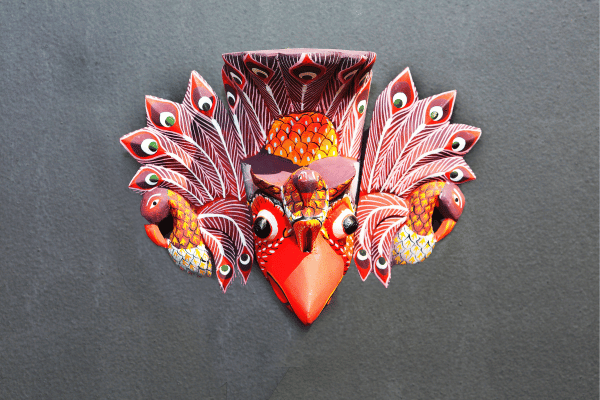
Ambalangoda is located in the Galle District of the Southern Province in Sri Lanka. It is situated along the southwestern coast of the country, approximately 90 kilometers south of the capital city, Colombo. Here are some key aspects of the geography of Ambalangoda:
- Coastal Area: Ambalangoda is a coastal town, bordered by the Indian Ocean to the west. It has a stretch of beautiful sandy beaches that attract tourists and locals alike. The coastline offers scenic views and opportunities for recreational activities such as swimming and sunbathing.
- Madu River: The Madu River is located near Ambalangoda and is an important geographical feature of the area. The river flows through a network of mangrove forests and forms a scenic landscape. Boat rides along the Madu River are popular among tourists, allowing them to explore the mangroves, visit small islands, and observe the diverse flora and fauna.
- Inland Areas: Moving away from the coast, Ambalangoda has inland areas characterized by paddy fields, plantations, and rural landscapes. These areas are predominantly used for agriculture, with farmers cultivating crops such as rice, fruits, and vegetables.
- Rivers and Waterways: Apart from the Madu River, there are several smaller rivers and waterways that flow through the region surrounding Ambalangoda. These water bodies play a vital role in irrigation, supporting agriculture in the area.
- Fertile Soil: Ambalangoda benefits from fertile soil, making it suitable for agriculture. The presence of fertile land allows for the cultivation of a variety of crops and contributes to the agricultural productivity of the region.
- Climate: Ambalangoda experiences a tropical climate. It is characterized by high temperatures and humidity throughout the year. The region receives a significant amount of rainfall, especially during the southwest monsoon season from May to September.
- Natural Beauty: The geography of Ambalangoda is known for its natural beauty. It is surrounded by lush greenery, coconut palms, and picturesque landscapes. The combination of the coastal and inland areas provides a diverse and scenic environment.
The geography of Ambalangoda, with its coastal charm, rivers, fertile land, and natural beauty, contributes to the overall appeal of the town. It influences the agricultural activities, tourism potential, and cultural aspects of the region.
Ambalangoda mask
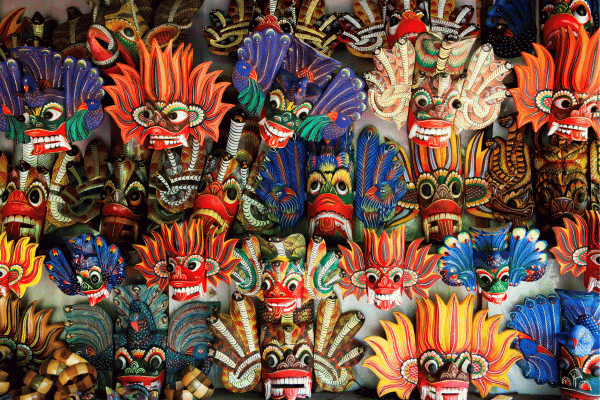
Sri Lankan wooden masks
Ambalangoda is renowned for its traditional masks, which hold significant cultural and artistic value. The masks of Ambalangoda are intricately crafted and painted by skilled artisans using traditional techniques that have been passed down through generations. Here’s some more information about Ambalangoda masks:
- Cultural Significance: Masks play a vital role in Sri Lankan culture and are used in various traditional rituals, ceremonies, and performing arts. They are believed to possess spiritual powers and are used to invoke blessings, ward off evil spirits, and represent different characters in folk dances and dramas.
- Traditional Craftsmanship: The mask-making process in Ambalangoda involves skilled artisans who meticulously carve masks from lightweight wood, such as balsa or kaduru. The wood is shaped, smoothed, and painted using vibrant colors, natural dyes, and traditional designs. Each mask is a unique piece of art, reflecting the creativity and craftsmanship of the maker.
- Mask Varieties: Ambalangoda masks represent a wide range of characters and personalities from Sri Lankan folklore and mythology. Some popular mask types include demons, gods, animals, and cultural figures. Each mask has distinct features, colors, and expressions that convey specific meanings and narratives.
- Rituals and Performances: Ambalangoda masks are used in traditional rituals and performances, such as the “Kolam” and “Raksha Keliya” (Devil Dance). These dances depict various mythological stories, and the masks bring the characters to life, captivating the audience with their vibrant colors and expressive designs.
- Mask Workshops and Galleries: Ambalangoda is home to numerous mask workshops and galleries where visitors can witness the mask-making process firsthand. You can observe the artisans at work, learn about the cultural significance of the masks, and even try your hand at painting or decorating a mask.
- Souvenirs and Collectibles: Ambalangoda masks make excellent souvenirs and collectibles. Whether you’re a mask enthusiast or simply looking for a unique memento, you can purchase masks from local artisans or specialized shops in Ambalangoda. These masks not only serve as beautiful decorations but also carry the rich cultural heritage of Sri Lanka.
The masks of Ambalangoda are a testament to the artistic traditions and cultural heritage of Sri Lanka. They have gained international recognition and are appreciated by art collectors, cultural enthusiasts, and tourists seeking an authentic Sri Lankan experience.
What are the places famous for visit in Ambalangoda
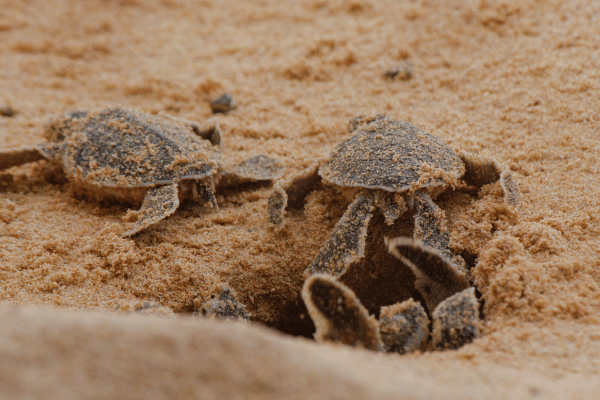
Turtle hatchery in Ambalangoda
When visiting Ambalangoda, there are several places of interest that you can explore. Here are some popular attractions and places to visit in Ambalangoda:
- Mask Museum and Workshops: Ambalangoda is renowned for its traditional mask-making. Visit the Mask Museum and various workshops to learn about the history, cultural significance, and the intricate process of creating traditional Sri Lankan masks.
- Ariyapala Mask Museum: This museum showcases a wide collection of traditional masks, providing insights into the craftsmanship and cultural heritage of Ambalangoda. You can observe different mask styles, characters, and learn about their roles in rituals and performances.
- Ambalangoda Beach: Enjoy the beautiful sandy beach in Ambalangoda. Take a leisurely stroll, soak up the sun, or swim in the refreshing waters of the Indian Ocean. The beach is known for its tranquility and is perfect for relaxation.
- Moonstone Mines: Visit the moonstone mines in Meetiyagoda, a nearby village. Moonstones are unique semi-precious gems found in Sri Lanka, and you can explore the mines, learn about the mining process, and even purchase some moonstone jewelry.
- Madu River Safari: Take a boat ride along the picturesque Madu River. Experience the tranquility of the mangrove forests, spot diverse birdlife, visit small islands, and witness the traditional prawn farming methods used by the locals.
- Maha Samudraramaya Buddhist Temple: Visit this ancient Buddhist temple, located in Ambalangoda. Admire the beautiful architecture, intricate wood carvings, and serene surroundings. The temple provides insights into Sri Lankan Buddhist traditions and offers a peaceful atmosphere for meditation and contemplation.
- Ambalangoda Market: Explore the vibrant local market where you can find fresh produce, spices, handicrafts, and various goods. Immerse yourself in the local culture, interact with the friendly vendors, and get a taste of the local flavors.
- Turtle Hatchery: Visit a turtle hatchery in Ambalangoda to learn about turtle conservation efforts. These hatcheries play a crucial role in protecting and preserving sea turtles. You can observe various turtle species and even participate in releasing baby turtles into the sea.
- Hikkaduwa: While not in Ambalangoda itself, the nearby coastal town of Hikkaduwa is worth a visit. It is known for its vibrant coral reefs, making it a popular destination for snorkeling and diving enthusiasts.
These are just a few of the highlights in Ambalangoda and its surrounding areas. Exploring these attractions will give you a taste of the rich cultural heritage, natural beauty, and local traditions that the town has to offer.







